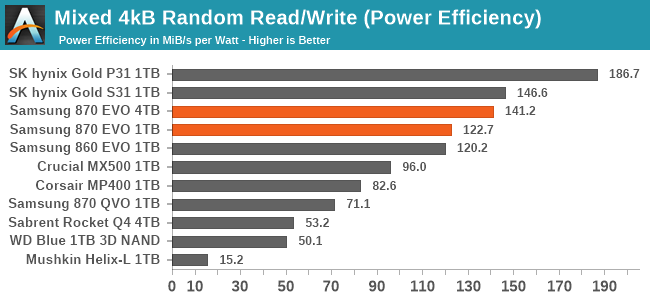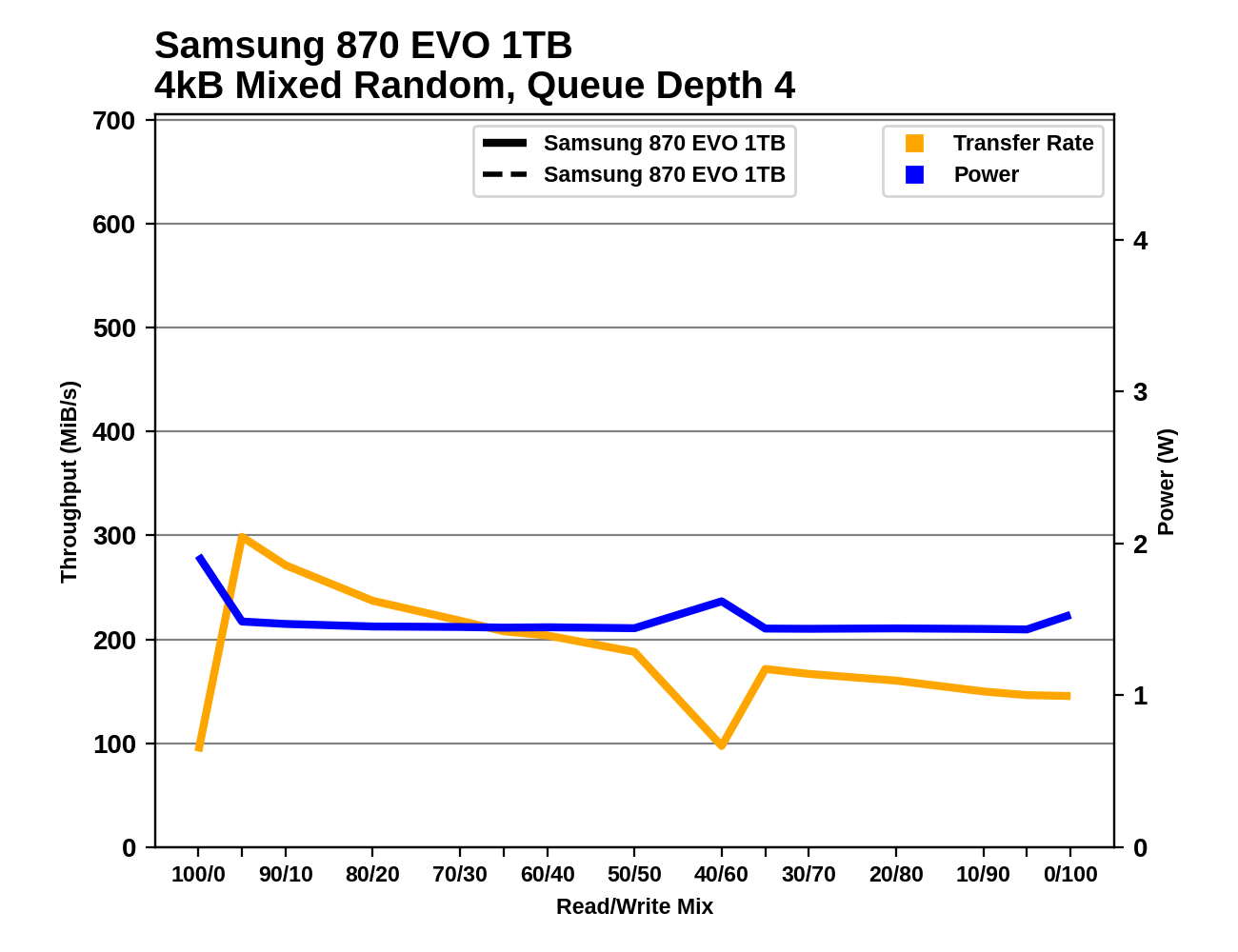The Samsung 870 EVO (1TB & 4TB) Review: Does the World Need Premium SATA SSDs?
by Billy Tallis on February 17, 2021 8:00 AM ESTMixed IO Performance
For details on our mixed IO tests, please see the overview of our 2021 Consumer SSD Benchmark Suite.
 |
|||||||||
| Mixed Random IO | Mixed Sequential IO | ||||||||
The mixed random IO test provides the Samsung 870 EVO with one of its biggest performance wins yet over the rest of the SATA field and the entry-level NVMe competition. But most of that comes from the capacity advantage the 4TB model has over most of these comparison drives; the 1TB 870 EVO is only about 5% faster overall than the 860 EVO. On the mixed sequential IO test, the SATA bottleneck keeps most of the performance scores within a fairly narrow range, and the 1TB 870 EVO's performance is actually a bit of a regression compared to its predecessor.
 |
|||||||||
| Mixed Random IO | Mixed Sequential IO | ||||||||
As with our separate tests of random reads and writes, the top efficiency scores for mixed random IO go to SK hynix, with Samsung's TLC drives turning in the next best scores and having a clear advantage over other competing brands. Over on the sequential IO side of things, the efficiency scores more closely mirror the performance scores, and the 870 EVO doesn't have any real advantage over other mainstream SATA drives.
 |
|||||||||
| Mixed Random IO | |||||||||
| Mixed Sequential IO | |||||||||
The 1TB 870 EVO's performance during the mixed random IO test is more consistent than the 860 EVO's, but still has a few unpleasant drops that aren't present for the 4TB model. On the mixed sequential IO test, the 1TB 870 EVO's performance is actually a bit less consistent than the 860 EVO. But aside from those occasional outliers, the general trend is for the 870 EVO to provide superior random IO performance and link-saturating sequential performance across a wide range of workload mixes.
Idle Power Management
Real-world client storage workloads leave SSDs idle most of the time, so the active power measurements presented earlier in this review only account for a small part of what determines a drive's suitability for battery-powered use. Especially under light use, the power efficiency of a SSD is determined mostly be how well it can save power when idle.
SATA SSDs are tested with SATA link power management disabled to measure their active idle power draw, and with it enabled for the deeper idle power consumption score and the idle wake-up latency test. Our testbed, like any ordinary desktop system, cannot trigger the deepest DevSleep idle state. For more details, please see the overview of our 2021 Consumer SSD Benchmark Suite.


The Samsung 870 EVO may feature an updated controller compared to the 860 EVO, but there's no real difference in idle power consumption, for either active idle or the desktop (non-DevSleep) idle states. Samsung's idle power figures are best in class, with SK hynix offering the only close competition.

The Samsung SATA drives all take about one millisecond to wake up from using SATA link power management. This is higher than several of the other SATA drives, but not really enough to be of much concern for system responsiveness.










136 Comments
View All Comments
Gigaplex - Wednesday, February 17, 2021 - link
A half-decent UEFI implementation will enumerate the bootloaders (or fall back to the default /EFI/Boot/bootx64.efi path) if the drive isn't configured in the motherboard.Billy Tallis - Thursday, February 18, 2021 - link
Unfortunately, "half-decent" can't be taken for granted. The ASRock motherboard in the new SSD testbed won't look in the standard path for a bootloader, but it will happily boot any Windows bootloader it finds.Duncan Macdonald - Wednesday, February 17, 2021 - link
SATA may be declining but is far from dead - many motherboards (and laptops) only have one NVMe slot - adding a SATA drive is far easier than replacing the NVMe drive when it is the system drive. Also NVMe drives bigger than 4TB are rare and expensive so anyone needing large storage capacity (over 4TB) has a choice between SATA or expensive NVMe.Oxford Guy - Friday, February 19, 2021 - link
Some motherboard brands also don't know how to design a motherboard properly, like Gigabyte.Drives like the Inland Performance Plus (Phison) don't fit in boards like the Z390 UD.
Tomatotech - Wednesday, February 17, 2021 - link
These SATA circuit board PCBs are really tiny. I’ve sometimes wondered about removing the PCB from the drive and just plugging it direct into the motherboard SATA socket, no cable or drive case needed. This wouldn’t work out of the box as I think the motherboard port and the drive’s port are both the same gender.So this would need 1) a small gender changer intermediary, and 2) a way to get the power cable in there as well. Depending on the orientation of the motherboard SATA port, there might be space next to it for the power cable.
Tomatotech - Wednesday, February 17, 2021 - link
The advantages would be fewer cables and less space taken in small cases.Tomatotech - Wednesday, February 17, 2021 - link
If SATA drive manufacturers added a secondary power port at the top of the PCB (which they won’t do) and included a small cheap gender changer for the data port, this could become a feasible life extender for using SATA in small or crowded cases.Qasar - Wednesday, February 17, 2021 - link
" I’ve sometimes wondered about removing the PCB from the drive and just plugging it direct into the motherboard SATA socket,"is that what nvme physically is ? :-)
Gigaplex - Wednesday, February 17, 2021 - link
No, NVMe is a protocol. You're thinking of M.2, which doesn't have to use NVMe. There are actually many M.2 drives that use the SATA protocol.Gigaplex - Wednesday, February 17, 2021 - link
You've basically just described M.2 SATA mode.